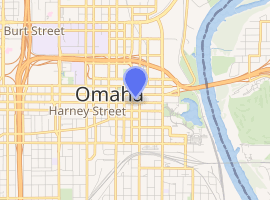Moon Theater
The Moon Theater was a silent movie theater at 1410 Douglas Street in Downtown Omaha, Nebraska.[1] The 1,600 seat theater was built on the site of Omaha's first movie theater, the Parlor.[1] In later years the theater was renamed the Town Theater and eventually the Cooper Theater. The building was demolished in 1976.[2]
| Moon Theater | |
|---|---|

| |
| Alternative names | Town Theater, Cooper Theater |
| General information | |
| Type | Movie theater |
| Location | Omaha, Nebraska |
| Address | 1410 Douglas |
| Country | United States |
| Coordinates | 41.258°N 95.934°W |
| Opened | August 30, 1918 |
| Closed | June 1974 |
| Demolished | 1976 |
| Owner | World Realty Co. |
| Design and construction | |
| Architect | Harry Lawrie of Mendelssohn, Fisher and Lawrie |
| Other information | |
| Seating capacity | 1,600 |
History
The Moon Theater was built for the World Realty Company in 1918 at 1410 Douglas Street,[1] and was built right next door to the existing Rialto Theater.[3] The Moon joined the company's other theaters, the Sun Theater at 1410 Farnam Street and the Muse Theater at 24th and Farnam Streets.[1] A fourth theater, the World Theater would, in later years, join the trio.[1][4]
The Moon Theater was a Moorish-style building designed by Harry Lawrie of the Omaha architectural firm of Mendelssohn, Fisher and Lawrie.[4] The brick and steel structure boasted an exterior finish of terra cotta, white tile and marble. Over the entrance canopy hung a sign thirty-feet in height with the image of a crescent moon. The interior included decorative painted panels depicting scenes of historic interest and locations within the U.S. National Parks.[1] Playing off the theater's name, the theater's marquee prior to its opening announced, "Moon Rises Next Sat Eve, Sessue Hayakawa in Gray Horizons".[1]
During a promotion for The Great Air Robbery, an Essex Motors touring car built to replicate a 600-pound airplane bomber was driven through the streets of Omaha to the entry of the Moon Theater.[5] In 1929, the Moon Theater became a Burlesque theater.[6] In 1933, it became the Town Theater, hosting both stage shows and movies. Its first stage show under its new name was Talk o' the Town.[7] It was remodeled in 1958 for Cinerama by the Cooper Foundation.[2][8] It opened as the Cooper Theater with a showing of South Pacific, for a record 78 weeks.[2] At the time, the South Pacific run set a record for the longest movie run.[2] The Cinerama equipment was later moved to the Cooper Foundation's new Indian Hills Theater. The last movie shown at the Cooper Theater was Serpico in June 1974.[2] The theater was demolished at the beginning of 1976.[2] The Union Pacific Headquarters building occupies the lot.
See also
- History of Omaha
- List of theaters in Omaha, Nebraska
- Astro Theater
- Creighton Orpheum Theater
References
- "Moon Theater Is Opened New Steps in Amusement". The Omaha World-Herald Newspaper, Omaha, Douglas County, NE, USA. August 31, 1919. p. 41.
- "Bringing Down House for Last Time". The Omaha World-Herald Newspaper, Omaha, Douglas County, NE, USA. January 1, 1976. p. 7.
- Spencer, Jeffrey (2010). Remembering Omaha. Nashville, Tennessee: Trade Paper Press, Turner Publishing Company. p. 80. ISBN 978-1-59652-650-1.
- "Half-Million Theater On Fifteenth Street". The Omaha World-Herald Newspaper, Omaha, Douglas County, NE, USA. April 17, 1921. p. 47.
- The Hudson Triangle, Volumes 9-13. Hudson Motor Company. 1919. Retrieved 21 March 2014.
- "How Shifting Years Have Changed Omaha Theaters". The Omaha World-Herald Newspaper, Omaha, Douglas County, NE, USA. October 27, 1929. p. 62.
- "Marion Players Seen in "Talk o' the Town"". The Omaha World-Herald Newspaper, Omaha, Douglas County, NE, USA. April 17, 1933. p. 9.
- Holston, Kim R. (2012). Movie Roadshows: A History and Filmography of Reserved-Seat Limited Showings ... p. 158. Retrieved 22 March 2014.